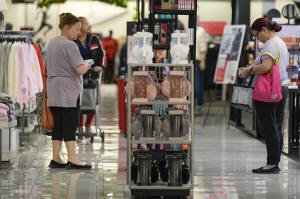US shoppers spent more at retailers last month in latest sign consumers
are driving growth
 Send a link to a friend
Send a link to a friend
 [October 18, 2024] By
CHRISTOPHER RUGABER and ANNE D'INNOCENZIO [October 18, 2024] By
CHRISTOPHER RUGABER and ANNE D'INNOCENZIO
WASHINGTON (AP) — Americans stepped up their purchases at retailers last
month as low unemployment, steady pay gains and rising stock and home
values helped sustain their willingness to spend despite higher prices.
Retail sales rose 0.4% from August to September, the Commerce Department
said Thursday, up from 0.1% the previous month and the third straight
increase. Online retailers, restaurants, and grocery stores all reported
higher sales.
Sales at gas stations fell, because of lower pump prices. The retail
sales figures aren't adjusted for inflation, and the prices of goods
fell slightly last month.
With the presidential election in its final weeks, Thursday's figures
provided the latest sign that household spending is fueling a steady
economic expansion even while inflation has cooled. In his campaign for
the White House, Donald Trump has insisted that sweeping new tariffs on
all imports and lower corporate taxes are needed to deliver healthy
growth. Vice President Kamala Harris has countered with proposals for
expanding tax credits for families with children and subsidizing home
construction to try to lower housing costs.
“Retail sales came in well above expectations and continue to defy the
‘weak economy’ thesis,” said Quincy Krosby, chief global strategist for
LPL Financial, a wealth management firm.
Restaurant sales jumped 1% from August to September, a sign that many
Americans remain confident enough in their finances to boost their
discretionary spending. Rising sales at sporting goods outlets point in
the same direction.

Clothing store purchases leapt 1.5% last month, though sales at
electronics and furniture stores dropped.
Last week, the government reported that consumer prices rose just 2.4%
in September from a year earlier, down from a peak inflation rate of
9.1% in June 2022 and barely above the Federal Reserve's 2% target. With
prices coming under control, the Fed cut its benchmark interest rate
last month for the first time in four years by a larger-than-usual
half-point. By year's end, economists expect two additional Fed rate
cuts, of smaller quarter-point increments, which should help ease
borrowing costs over time.
Yet the healthy pace of retail sales could strengthen the hand of Fed
officials who have expressed a more cautious approach to rate cuts. Last
month's half-point rate cut had coincided with worries that the job
market might be rapidly weakening. But then the jobs report for
September showed that hiring picked up last month, and the unemployment
rate fell to a low 4.1%.
Many analysts say they think cooler inflation and lower borrowing rates
will help support the economy in the coming months. Last quarter, the
economy grew at a solid 3% annual rate.
[to top of second column] |

Shoppers peruse merchandise at a Kohl's in Ramsey, N.J., Thursday,
Oct. 10, 2024. (AP Photo/Seth Wenig)
 Still, research by the Fed has found
that it’s mostly upper- and middle-income Americans who are driving
the increased retail spending by consumers. Many lower-income
households, by contrast, have struggled to keep up with sharply
higher prices and interest rates, and have increased their spending
by much less.
The lagging outcome for lower-income consumers marks a shift from
before the pandemic, according to a research note by Sinem Hacioglu
Hoke, a Fed economist, and two colleagues. Before the pandemic, they
found, retail spending rose for all income groups at roughly the
same pace. But about three years ago, upper- and middle-income
consumers started to spend at much faster pace than lower-earning
consumers.
By August 2024, spending on retail goods was nearly 17% higher than
it was in January 2018 for upper-income households, defined as those
making more than $100,000. For middle-income households — those
earning $60,000 to $100,000 — their spending rose 13.3% during the
same period. And for those earning less than $60,000, spending has
risen just 7.9% since 2018, and it actually fell from mid-2021
through mid-2023.
Thursday’s retail sales report arrives amid expectations for a solid
holiday shopping season, though perhaps not as robust as last
year’s, with many shoppers under pressure from higher prices despite
the easing of inflation. The National Retail Federation has
predicted that shoppers will increase their spending in November and
December by between 2.5% and 3.5% over the same period a year ago.
During the 2023 holiday shopping season, spending had surged by a
stronger 3.9% from 2022.
To try to pull in shoppers, many retailers, from the holiday décor
online retailer Balsam Hill to the crafts retailer Michaels, are
displaying holiday merchandise and marketing earlier than they did a
year ago. For the first time, Balsam Hill transformed what is
traditionally its fall catalog, sent in September, into a holiday
book.
The company’s chief executive, Mac Harman, said its sales of holiday
decor spiked in mid-September, a month earlier than it had a year
ago. Harman said he also noticed that Halloween decor sold briskly
in September, also a month earlier than in 2023.
Michaels, based in Irving, Texas, said it was setting up its holiday
decor shop called Sprinkle Shop now, nearly a month earlier. It is
also displaying its do-it-yourself offerings three weeks earlier
than usual because some of its customers appear to want to save
money by making their own gifts.
___
D'Innocenzio reported from New York.
All contents © copyright 2024 Associated Press. All rights reserved |